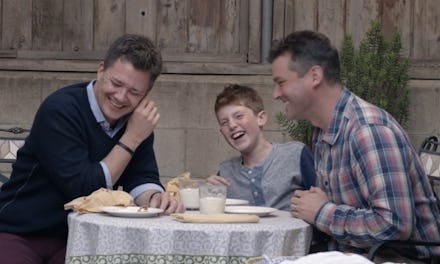Here's What's Missing From All Those Heartwarming Gay-Friendly Ads

Speaking at a presentation on the cultural history of the LGBT community in advertising last Tuesday, Ogilvy & Mather Worldwide Chief Creative Officer Tham Khai Meng contended that we have entered the age of a "rebirth" of LGBT advertising.
This is mirrored by the community's social and political progress over the past 20 years. Indeed, there was a 20% increase in the buying power of the LGBT community from 2006-2012. The projected total buying power hoverings just over $800 billion annually.
Indeed, it's clear the LGBT community has quickly become a highly coveted market, and businesses are marketing products with its members in mind. "How does sexual identity influence the way we live?" Meng asked the audience, before documenting the last 70 years of advertising geared toward the LGBT community in his talk entitled, "LGBT: Let's Walk Together."
However, there's a darker side to this effort to tap into the "pink dollar" market: The promotion of one type of "gay family," which has actually lessened LGBT visibility. This trend is erasing the community's diversity in favor of the stereotypical — and non-threatening — gay couple marketers think mainstream America will find palatable.
Meng's presentation on "the long journey toward inclusion" hinged on what he called a sea change of LGBT acceptance beginning in the 1990s, following the AIDS crisis and a re-imagining of the gay individual as a human being in the collective consciousness. Before that time, LGBT advertising was relegated to the grey area of subliminal codes, which Meng called "gay window dressing." Take for example, this ad for Ivory Soap:
Image Credit: The Huffington Post
Interestingly, unlike lesbian sexuality, advertising images portraying gay male homoeroticism were pervasive throughout the 20th century, especially those reflecting the blatant homoeroticism of wartime culture. Cannon towels was one of the most notorious brands for this, even going so far as to compare the scene of soldiers relaxing to the infamous hedonism of the ancient Roman bathhouses.
Image Credit: The Village Voice
This trend, of serving the "G" (gay) population primarily if not solely, still holds today. And it isn't surprising, since the largest percentage of the "pink dollar" is wielded by gay white men. According to Experian's 2013 LGBT Report, gay men individually earned $60,000-$63,300/year, while lesbians individually earned $38,000-$43,500/year. The household income of married gay men in 2013 was $115,500 annually, while that of lesbians was only $88,500. Indeed, as the report concludes, "Gay men have the highest discretionary spending per capita" — not straight men.
Meng had very little data on the lesbian consumer, and there was no advertorial footage provided to demonstrate if and how businesses advertise to lesbians. A few recent campaigns do come to mind, however, especially the mainstream campaigns featuring Ellen DeGeneres for brands such as Covergirl and JCPenny.
But Meng did note what is a central paradox in LGBT marketing: How do you target a minority community when its defining characteristic is being invisible? So far, the solution has been to create intimate situations that feature two people of the same sex, such as the JCPenny ad below.
Image Credit: The Huffington Post
The way companies have chosen to create these "LGBT ads" has resulted in more visbility, which is appreciated. But the prevailing strategy is also erasing some of the diversity inherent to the community. And that's a serious problem. Sexuality itself is not visible — queerness is much more about societal perceptions of gender presentation and their conformity — or divergence from — the cultural norm.
Often, societal acceptance is born out of sameness, just like how marketing is based off the principle that people will be attracted to lifestyles similar to their own. The need to see someone else as the same often necessitates the erasing differences — and not necessarily for the better.
The LGBT community — specifically the lesbian and gay community — transitioned from exclusion to acceptance in the 1990s by re-imagining themselves in terms of image, as well as through acting on a political agenda that emphasized institutional acceptance, such as same-sex marriage. Perhaps that is why representation of the lesbians and gays in the media is still so boring. The salacious ads celebrating rugged homoeroticism of the mid-20th century would not be found in 2014 mainstream culture. In order to gain acceptance, gays had to be inoculated, becoming something less aggressive or uncomfortable, a minority character who doesn't make too much trouble for his straight white friends. (Think, Modern Family.) Generally white, clean cut and handsome, these are the representatives portrayed in advertisements for products like Coke, Ikea, Chevy and, most recently, Honey Maid.
But if the price of acceptance is conformity, perhaps the LGBT community should take a moment to think about what "acceptance" in this context actually means. One thing seems clear: If the recent trends in media and advertising is any indication, the "innocuous gay" is here to stay, at least for the time being.